A Comprehensive Guide to Cleaning Acrylic Bathtubs
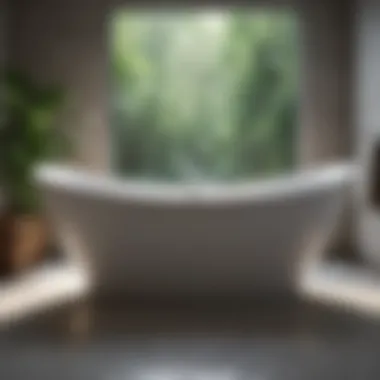
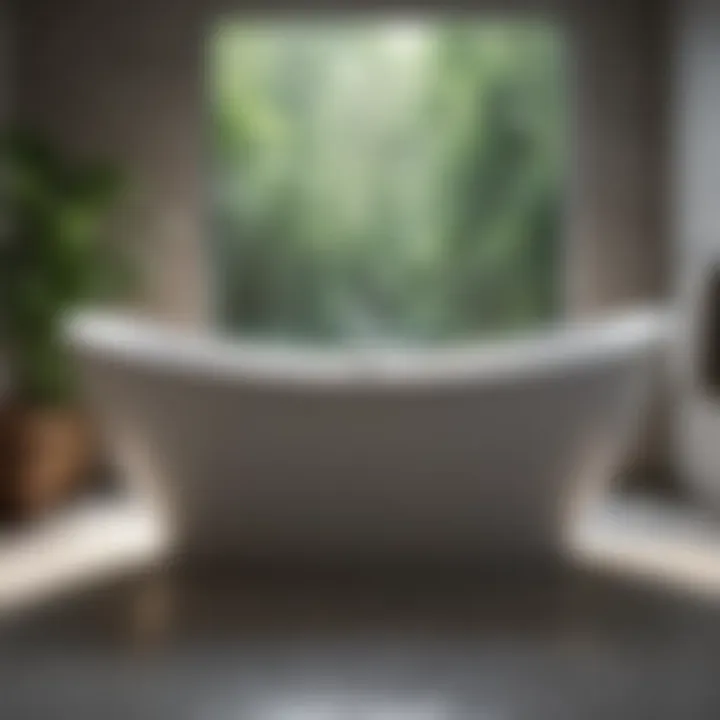
Intro
Cleaning an acrylic bathtub requires specific techniques and methods. Acrylic material is known for its durability and ease of repair. However, it can be susceptible to scratches without proper care. Understanding the unique properties of acrylic will guide you in selecting the right materials to maintain a pristine appearance. This guide seeks to equip you with effective strategies for maintaining your acrylic bathtub while avoiding potential damage.
Understanding Acrylic:
Acrylic bathtubs are made from a non-porous material that prevents mold and mildew. Their light weight and vast design variety make them popular choices. However, many cleaning solutions and materials can damage the surface.
- Pros of Acrylic:
- Cons of Acrylic:
- Resistant to mold and bacteria.
- Lightweight and easy to install.
- Comes in various colors and styles.
- Can be scratched easily.
- Not resistant to harsh chemicals.
This understanding reinforces the importance of gentleness in cleaning methods in order not to compromise the material.
Choosing the Right Cleaning Agents:
It is essential to choose cleaning agents carefully when dealing with acrylic. Products that are acetone-based or citrus-based often lead to permanent damage. Instead, look for non-abrasive cleaners that do not contain alcohol or harmful acids.
Here are a few recommended products:
- Mild Dish Soap
- Baking Soda mixed with water to create a paste
- White Vinegar
- Hydrogen Peroxide
Always test a small area before fully applying any cleaning solution on the entire surface of your bathtub. This will serve as a precaution to prevent unwanted outcomes.
Effective Cleaning Technique:
To effectively clean an acrylic bathtub, follow these steps:
- Gather materials: You will need a soft cloth, moderate cleaners, and warm water.
- Dust the surface: Wipe down to remove loose debris.
- Prepare cleaner: Mix dish soap with warm water or prepare the baking soda paste.
- Apply gently: Use your cloth to rub the mixture on the stained areas. Utilize soft motions, taking care not to apply too much pressure.
- Rinse completely: It’s critical to rinse thoroughly, removing all the cleaner residue.
- Dry the surface: A dry, soft towel will help prevent streaks.
A significant mistake homeowners often make is using abrasive pads or scrubs. These can lead to permanent scratches, ruining the surface of the beautiful acrylic bath.
Addressing Common Stains:
Some common stains may need specialized attention. For example, soap scum will require more frequent cleaning, while rust from metal objects can also be problematic.
- General stains: Use the dish soap mix or baking soda.
- Soap scum: White vinegar can cut through more stubborn scum.
- Rust marks: Apply hydrogen peroxide and leave for five minutes before washing off.
In summary, maintaining an acrylic bathtub requires careful selection of gentle cleaning agents, appropriate technique, and timely addressing of stains. The points covered offer a detailed direction towards ensuring longevity and look, preserving a clean bathing experience.
Understanding Acrylic Bathtubs
Understanding the composition and characteristics of acrylic bathtubs is essential for effective cleaning and maintenance. Acrylic is a widely accepted material in modern bathroom fixtures and is favored for its warmth and ease of care. Grasping the properties and benefits of acrylic helps homeowners make informed decisions about maintaining these fittings. It also provides insights into why specific cleaning methods and tools are recommended.
Properties of Acrylic
Acrylic bathtubs possess distinct properties that set them apart from other materials. Firstly, acrylic is lightweight compared to cast iron or fiberglass. This makes installation and handling easier. Additionally, it has a smooth surface that is naturally non-porous. This helps to prevent moisture absorption, which diminishes the chances of mold and mildew developing.
Acrylic also retains heat effectively, providing a warm bathing experience. The vibrancy of acrylic can be maintained with appropriate care. This means that its color will not fade easily as some other bathtub materials might with time. To top it off, acrylic is available in a range of shapes and sizes, which allows for versatility in design to fit different bathroom layouts.
Advantages of Acrylic Bathtubs
The advantages of acrylic bathtubs are numerous. Firstly, they come in a variety of styles and colors, allowing homeowners to match their bathroom aesthetically. Secondly, the smooth surface significantly reduces cleaning time. The non-porous nature means dirt and grime do not latch on easily, simplifying sanitation efforts.
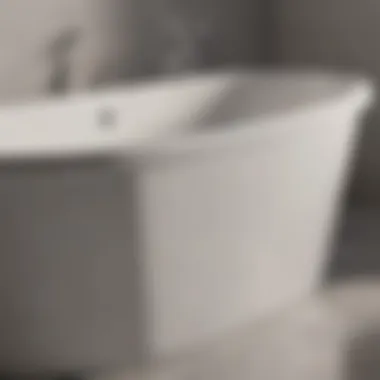
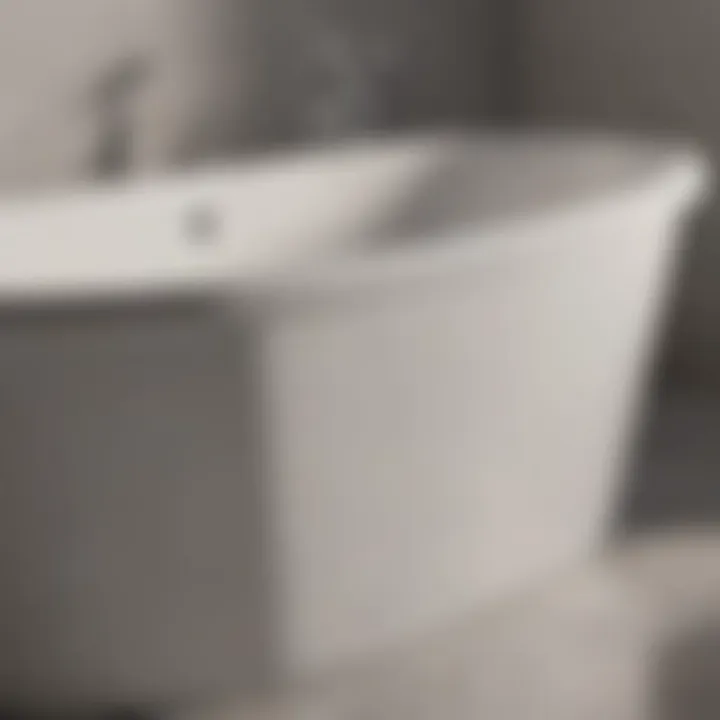
Moreover, acrylic bathtubs are known for their durability. With proper care, they resist chipping and cracking better than some alternatives. This durability often correlates to a longer-lasting investment in home fixtures.
Another point to consider is the cost-effectiveness of acrylic. Though they provide luxurious feels, they tend to be priced lower than materials like porcelain or stone. Thus, homeowners can achieve a high-end look without overspending.
Understanding the material and its properties paves the way for effective and safe cleaning methods. It ensures that the aesthetic and structural integrity of the bathtub is long-lasting.
Why Regular Cleaning is Essential
Cleaning an acrylic bathtub is not just a mere task in household maintenance; it is crucial for preserving both its aesthetic value and functional aspects. Regular cleaning prevents the accumulation of unwanted substances that may contribute to stains and other contaminants. When an acrylic bathtub is left uncleaned, it invites various forms of buildup, compromising the elegance it once held. This article examines the importance of consistent cleaning practices and the lasting benefits that follow.
Preventing Stains and Buildup
Over time, various substances, such as soap residue, body oils, and mineral deposits may find their way onto the acrylic surface. This can lead to unattractive discoloration and stubborn stains, which can be difficult to remove. Regular cleaning works proactively to eliminate these factors, ensuring they do not have the chance to settle deeply into the tub's surface. Moreover, maintaining a routine cleaning schedule limits the potential for developing persistent bacterial growth, which can be hazardous to your health.
Preventive measures like daily or weekly light cleaning can make a significant difference:
- Use a gentle cleaner after each use to wipe down the surface.
- Rinse thoroughly to remove any residues.
- Avoiding harsh chemicals that could damage the acrylic material.
Taking these simple actions makes a mark in keeping your bathtub not only visually appealing but hygienic as well. In essence, prevention serves as a far more resource-efficient solution than rectifying issues after they arise.
Maintaining Gloss and Finish
An acrylic bathtub is designed with a glossy finish that enhances its beauty. Regular cleaning helps to maintain this desirable gloss, preventing the surfaces from becoming dull over time. Factors such as mineral deposits and buildup of soap scum can erode this finish, far transcending aesthetics. Over time, neglection can lead to the need for professional restoration services, which are often quite expensive.
Consistent maintenance includes:
- Using non-abrasive sponges or cloths during cleaning to avoid scratching the surface.
- Retraining habits regarding what products are used around the tub. For instance, opting for cleansers specifically designed for acrylic can greatly extend the lifespan of the finish.
- Applying a soft coating of wax can provide additional protection and shine if appropriate.
It is evident that establishing a cleaning routine fosters both the look and durability of your acrylic bathtub, allowing it to simulate the freshness of its initial installation much longer. Taken together, these considerations underscore not just the immediacy of appearance, but the value of statutory persistance in care processes.
Necessary Cleaning Supplies
Cleaning an acrylic bathtub efficiently requires an understanding of the necessary supplies. While it may seem straightforward, the selection of appropriate cleaning agents and tools plays a critical role in achieving a clean and well-maintained bathroom fixture. Knowledge about these elements aids homeowners in preserving their bathtubs' aesthetic appeal.
Recommended Cleaning Agents
When choosing a cleaning agent for acrylic bathtubs, it is essential to select products that are specifically designed for this material. Using harsh chemicals can lead to dulling the surface or causing irreversible damage. Look for cleansers that are sulfate-free and contain gentle yet effective ingredients. A few widely recommended brands include:
- Lime-A-Way: Effective for hard water stains.
- Simple Green: A multipurpose cleaner that is safe for acrylic.
- So Safe Bathtub Cleaner: Designed specifically for acrylic fixtures.
These products are non-abrasive and will not scratch the surface, keeping the gloss intact. Always read labels to ensure compatibility with acrylic.
Tools for Effective Cleaning
Cleaning tools can greatly enhance the effectiveness of your cleaning routine. It is critical to avoid abrasive materials such as steel wool or coarse scrubs; these can cause significant scratching that can ruin the surface finish of the bathtub. Instead, opt for the following tools:
- Soft Sponges or Cloths: Microfiber towels are also an excellent choice.
- Soft- bristled Brushes: Ideal for issues like soap scum buildup but gentle enough not to scratch.
- Plastic Scrapers: Useful for carefully removing stubborn dirt without harming the acrylic.
Collectively, these tools combine effectiveness without compromising on the integrity of your tub. Having the appropriate supplies ready can transform regular cleaning into an uncomplicated and quick task.
Remember, investing in suitable cleaning agents and tools defines the effectiveness of maintenance. Managing any common stains promptly will yield the best results, contributing significantly to the longevity of your acrylic bathtub.
Preparation for Cleaning
Cleaning an acrylic bathtub requires proper preparation. This not only enhances the effectiveness of the cleaning process, but also protects the material. Without the right steps, one can easily damage the finish or weaken the structural integrity of the bathtub.
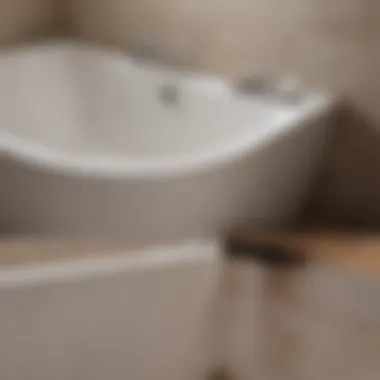
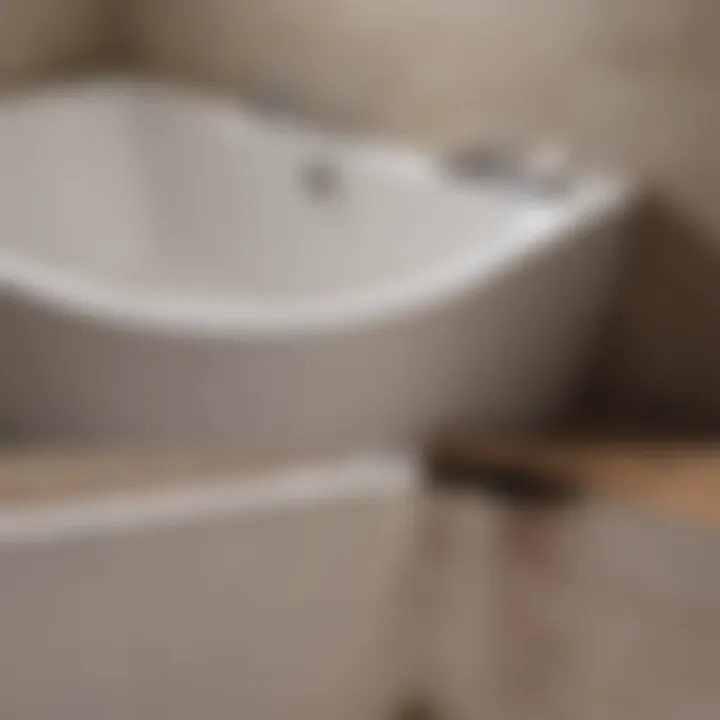
Safety Precautions
Before engaging in the cleaning process, it's crucial to take safety precautions. Depending on the cleaning agents selected, there may be irritants or harmful ingredients in these products. Therefore, always wear gloves to protect your skin from potential irritants. Using masks may also be beneficial if the cleaning agents produce dust or strong fumes. Good ventilation can make a significant difference, so while cleaning, make sure the room is well-aerated to two-fold the safety.
Flat surface areas around the bathtub should be cleared as well. Close the toilet lid and cover any metallic or electronic items that may attract damaging liquids or splashes is important for categorically avoids accidents. This planned action creates better results with cleaning, ultimately ensuring the very safety of dwellers.
Removing Items from the Bathtub
It is essential to clear any items from the bathtub before cleaning. Items like shampoo bottles, soap dishes, and bath mats typically collect grime and debris, making the cleaning process more complicated. Automatically ensuring a clean area primes the bathtub surface for effective scrubbing and rinsing.
- Remove all products: Start by taking everything out of the bathtub. Dispose of items that have expired or are no longer used.
- Railings and Other Accessories: If your tub features any grab bars or similar accessories, plant clear care to safely remove any fixtures along the edges.
- Bath Mats: Rugs or mats that trap dirt should also be taken off. Clean them separately according to their own material requirements.
After following these points, the preparation process builds a chosen environment optimal for achieving a clean, well-maintained acrylic bathtub. A little advance work makes the task at hand more efficient.
Step-by-Step Cleaning Process
The cleaning process for acrylic bathtubs is critical to maintaining both their appearance and longevity. A systematic approach helps in achieving optimal results while minimizing the risk of damaging the surface. Given the vulnerability of acrylic to scratches or discoloration, a step-by-step method allows for minimal aggression towards the material. By carefully following established procedures, homeowners can avoid issues such as dulling surfaces or adhering stains that become difficult to remove over time.
Initial Rinse
Before applying any cleaning agents, an initial rinse of the bathtub is essential. This step serves several purposes. First, it removes any loose debris such as hair or dust that may have accumulated. Second, rinsing provides a damp surface that will enhance the effectiveness of subsequent cleaning agents. It is preferable to use lukewarm water as it helps dissolve substances, making it easier for the cleaning agents to work.
Applying Cleaning Agents
Once the initial rinse is complete, the choice of cleaning agent is crucial. Use a product specifically formulated for acrylic bathtubs, avoiding harsh chemicals like bleach or ammonia. These substances can cause irreparable damage to the surface. Apply the agent evenly across the surface while paying attention to areas with visible stains or buildup. Allow the cleaning solution to sit for a short duration as per the product instructions to maximize its efficacy before moving on to scrubbing.
Scrubbing Techniques
When it comes to scrubbing, it is vital to select the right tool. A soft sponge or an adaptable microfiber cloth will do the job without harming the acrylic. Begin scrubbing gently, focusing on stained areas while ensuring an all-over clean. Refrain from using steel wool or abrasive cleaners, as these can scratch the surface and lead to a dull appearance. Areas with stubborn stains might require slightly increased friction but maintain a delicate approach to avoid distressing the bathtub material.
Final Rinse and Drying
After scrubbing is complete and stains have been addressed, a thorough rinse is necessary. Ensure that all traces of the cleaning agent are washed away, as residual product can lead to a buildup. After rinsing, it is ideal to dry the bathtub with a clean, soft towel. Drying is not just about aesthetics; it also helps prevent water spots that occur when water evaporates and leaves mineral deposits behind. Completing this final step leaves an immaculate and gleaming acrylic surface, ready for subsequent use and care.
Remember, gentle handling and consistent care will keep your acrylic bathtub looking new for years to come.
Addressing Specific Stains
When it comes to maintaining an acrylic bathtub, addressing specific stains is a critical aspect of preserving its aesthetic appeal and functional longevity. Stains not only detract from the tub's overall appearance but can also lead to more complex issues, such as deterioration of the material over time. Understanding the nature of these stains helps in selecting the appropriate cleaning methods and products, ensuring the acrylic maintains its glossy finish and prevents any lasting damage.
Hard Water Stains
Hard water stains occur as a result of mineral deposits, primarily calcium and magnesium, when water evaporates. These unsightly marks can build up around the faucet and along the tub's surface if not regularly treated. Removing hard water stains promptly is essential, as prolonged exposure can lead to etching or dulling of the acrylic surface.
A proactive approach involves using natural cleaning solutions. Mix equal parts of vinegar and water in a spray bottle and coat the stained areas. Allow it to sit for a few minutes before gently wiping with a soft cloth or a sponge. If necessary, repeat the process to fully eliminate the stains. Regular maintenance, with special attention to areas prone to buildup, can reduce the likelihood of persistent stains.
Soap Scum
Soap scum builds up when soap residue combines with minerals found in hard water. This forms a rough, cloudy layer on the surface of the tub, making it visually unappealing. Effective removal requires careful consideration of cleaning agents.
Chemical cleaners specifically designed for soap scum can be effective, but care is needed. When choosing, select a product labeled safe for acrylic surfaces to prevent potential scratching or fading. A gentle streamlined approach involves applying the product, allowing it to penetrate for a few minutes, and lightly scrubbing with a microfiber cloth. Pay special attencion to edges and corners where soap scum tends to linger. Regular rinsing after use can greatly mitigate its formation.
Mold and Mildew
Mold and mildew thrive in damp environments, making bathrooms particularly susceptible. The organic appearance of mold is not only unattractive but can also pose health hazards. Controlling these growths starts with both prevention and appropriate cleaning strategies.
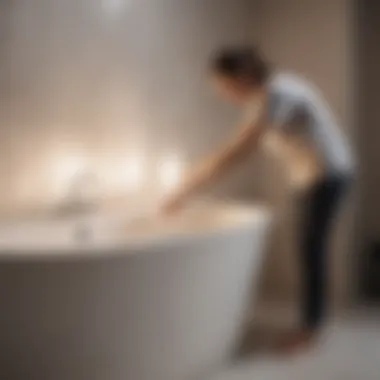
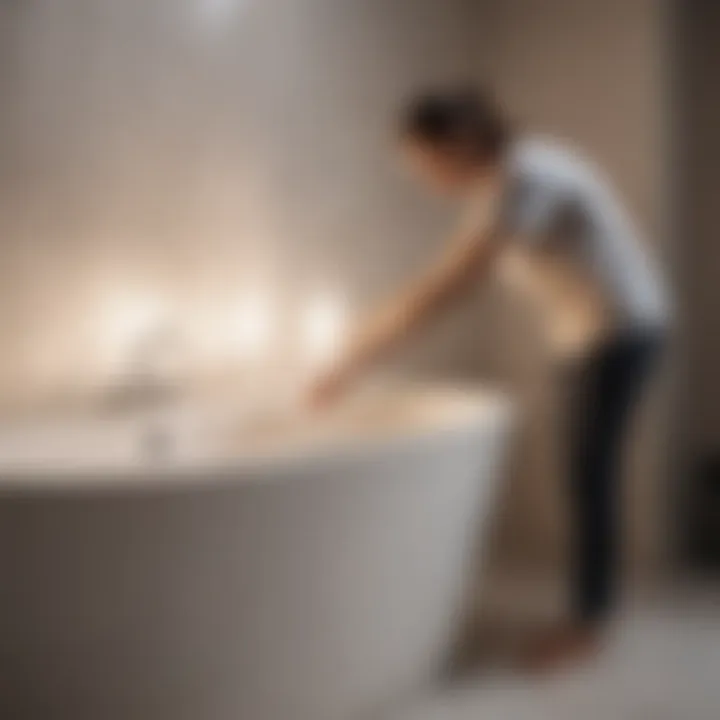
To treat existing mold and mildew stains, create a two-part solution of water and white vinegar, spraying liberally on affected areas. After waiting for approximately 10-15 minutes, scrub with a soft bristle brush before rinsing thoroughly. Preventing future infestations can be achieved by ensuring the bathroom remains well-ventilated. A dehumidifier can significantly lessen moisture and therefore limit the growth of these unwanted stains.
Proper cleaning techniques for specific stains preserve the integrity of your acrylic bathtub and ensure it remains inviting and sanitary for family and guests.
Regular Maintenance Tips
Regular maintenance is crucial for preserving the integrity of an acrylic bathtub. The primary purpose of establishing a cleaning routine is to minimize the buildup of dirt, grime, and stains, which can degrade the finish over time. Consistent care not only maintains the visual appeal but also extends the lifespan of the bathtub. Here, you can discover practical habits aimed at addressing both daily and monthly tasks essential for keeping your acrylic bathtub in optimal condition.
Daily Cleaning Habits
Daily cleaning habits are an excellent first line of defense for your acrylic bathtub. These small routines can serve to prevent significant messes from building up, making deep cleaning sessions less laborious. Consider the following aspects when formulating your daily routine:
- Rinse: After each use, spend a few moments rinsing the tub to wash away soap scum and body oils. This minimizes buildup and keeps the tub cleaner between more thorough cleanings.
- Incorporate Mild Detergents: Using a gentle dish soap diluted in warm water is an effective approach. Apply this with a soft cloth or sponge to avoid scratches. It's advisable to rinse thoroughly after using soap to prevent residue.
- Pooling Water Prevention: Standing water, if left too long, can lead to the formation of hard water stains. Ensure to drain the tub effectively, especially after bath experience.
By incorporating these daily habits, you contribute significantly to maintaining the lustrous appearance of your bathtub.
Monthly Deep Cleaning
Conducting a thorough cleaning on a monthly basis is recommended to ensure deep-rooted dirt and stains are eliminated effectively. This approach allows for addressing areas that regular cleaning might miss:
- Showcase Necessary Tools: Have at-hand a soft-bristled brush to tackle stubborn grime, as well as microfiber cloths for wiping down surfaces. Select specific cleaner that is suitable for acrylic, avoiding any bleach or harsh chemicals.
- Focus on Stains: During your deep clean, pay attention to areas prone to soap scum accretion or hard water halos. Use a vinegar-water mixture applied with a sponge to gently dissolve these stubborn patches. Always follow up with a thorough rinse.
- Tackle the Overflow Drain: The overflow drain can often attract buildup, so it should be cleaned thoroughly. Ensure the mixture reaches this area and that any collected debris is removed.
- Inspect for Damage: Regularly check for any signs of scratches, cracks, or discoloration, addressing these promptly to prevent further damage.
A well-defined monthly cleaning not only revitalizes your acrylic bathtub but also signifies a proactive step in caring for one of the important features of your bathroom.
In short, regular maintenance routines integrate seamless cleaning practices that keep your acrylic bathtub looking fresh, preventing undue stress on the material while promoting a healthier bathing environment.
Common Mistakes to Avoid
Cleaning an acrylic bathtub is a delicate task. Various mistakes can impact its integrity and appearance. Therefore, being informed about common errors can help homeowners maintain the beauty and lifespan of these fixtures.
Using Abrasive Cleaners
Many people mistakenly reach for harsh, abrasive cleaners when they see grime or stains on their tubs. This choice can lead to permanent damage, as acrylic is susceptible to scratches. Such abrasive products might include powders or scrubbing pads.
Instead, it is better to select non-abrasive, gentle cleaners specifically designed for acrylic surfaces. These will clean effectively without causing micro-scratches or dulling the surface sheen. When considering a cleaning agent, always check the label for compatibility with acrylic. Keep in mind that even some seemingly mild products might have ingredients that could harm the finish over time.
Scrubbing Too Hard
Another frequent mistake is applying excessive force while scrubbing. Many individuals think that harder pressure will yield better results, but this is a misconception, particularly with acrylic tubs. Using too much pressure can lead to deformities and surface scratches, undermining the aesthetics of the bathtub.
Instead of utilizing brute force, focus on applying light, consistent pressure with a soft cloth or sponge. Patience is key. Clean small areas at a time and allow the cleaner some time to work effectively. This light cleaning method preserves the smooth surface and retains the original luster.
Consistent use of gentle techniques can significantly enhance the bathtub's lifespan.
Being aware and avoiding these common cleaning mistakes not only protects the tub but also ensures a more enjoyable bathing experience for everyone.
The End
Cleaning an acrylic bathtub is crucial not just for its appearance, but also for its longevity. Maintaining a consistently clean bathtub is beneficial for several reasons. First, it enhances the visual appeal of the bathroom, inviting a sense of comfort and relaxation for users. Second, regular maintenance prevents the buildup of stains and germs, ensuring a hygienic bathing experience.
Additionally, using the proper cleaning techniques preserves the sheen and surface integrity of the acrylic material. With the right methods, homeowners can avoid dings or scratches that may lead to more severe damage over time. These factors highlight the importance of understanding the nuances of cleaning methods, products, and routines specifically for acrylic bathtubs, as it125 not only aids in cleaning but also enriches the overall elegance of your home.
Recap of Cleaning Methodology
Throughout this guide, we explored a comprehensive methodology for cleaning an acrylic bathtub. Initially, preparing the area by removing items and taking safety precautions sets the stage for effective cleaning. Following this, using gentle cleaning agents and appropriate tools minimizes the risk of damaging the surface. The alternating steps of rinsing, applying cleaning solutions, and scrubbing are vital to achieving a spotless finish.
The significance of addressing specific types of stains, like hard water and soap scum, cannot be understated. Each can have unique challenges requiring tailored approaches to counteract effectively. Summarizing the detailed cleaning process outlined here enables any homeowner to tackle their cleaning faithfully and with confidence.
Encouragement for Consistent Care
Maintaining the cleanliness of an acrylic bathtub is not simply a one-time task but requires a commitment to consistency. Developing daily cleaning habits can vastly improve the minimal effort needed during weekly or monthly thorough cleanings. These can range from quick rinses to utilizing gentle wipes periodically. Such habits not only keep the bathtub looking pristine, but also extends its lifespan.
Moreover, committing to a monthly deep cleaning ritual allows for a more meticulous approach to tackle any lingering stains or buildup. Continuous care plays a crucial role in ensuring that the bathtub remains not only datail but also gleams with allure. Homeowners should embrace a lifestyle that values maintenance as a key part of their home upkeep, integrating these practices into their routine to truly preserving their bathing sanctuary.







